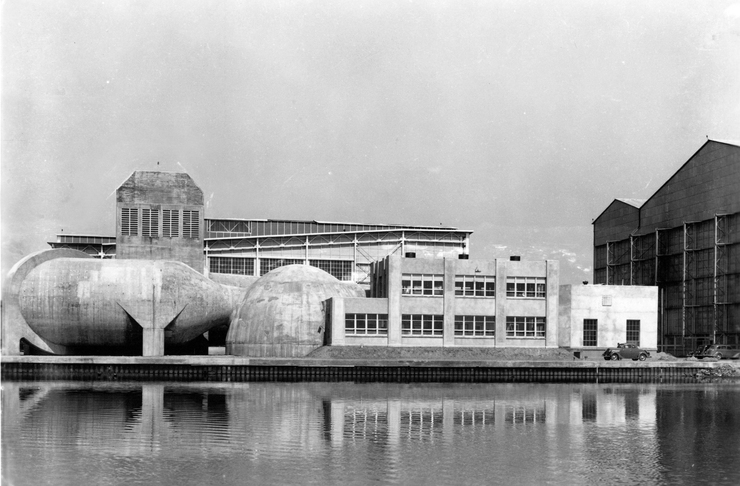
| Click to see more photos: |
The 8-Foot High-Speed Wind Tunnel, Langley Field, Virginia
Completed March 1936. “The National Advisory Committee for Aeronautics constructed this 8-foot high-speed structure for test purposes. It is the largest structure of this kind in the world and is built of reinforced concrete throught except that the air passages are lined with steel plates. Large-scall airplane models and full-sized airplane parts are investigated for the effects of air velocities varying from 85 miles per hour up to the speed of sound. The tunnel is equipped with an 8,000-horsepower motor which drives an 18-blade propeller 16 feet in diameter. The working space in the dome is at a negative pressure, while tests are being made, to simulate an altitude of 12,000 feet at full speed. To withstand these pressures, when operating at high speed, the test chamber is dome-shaped and the operating personnel enter and leave through air locks. The building was designed and constructed under the supervision of members of the Committee staff at a cost of $474,000 and it was completed in March 1936. Other facilities available at Langley Field, available to the Committee, are a 24-inch wind tunnel capable of producing wind volocities of 750 m.p.h., a free-spinning wind tunnel, and an engine research laboratory, all of which were constructed with P.W.A. funds at an approximate cost of $200,000.”[1]“The world's first large high speed tunnel, the HST proved vital during World War II. Evaluating stability-control problems of the Lockheed P-38 Lightning fighter in the 8-Foot HST, Langley engineers devised the ‘dive recovery flap,’ a wedge-shaped flap on the lower surface of the wings that allowed sufficient lift for a pilot to pull out of steep dives. This ingenious feature subsequently was incorporated in the design of a number of U.S. fighter aircraft, including the YP-38 Lightning, the P-47B Thunderbolt, the A-26B Invader, the P-59 Airacomet (the first U.S. jet aircraft), and the P-80 Shooting Star.”[2]
“First operational in the spring of 1936, the 8-Foot High Speed Tunnel (later called the 8-Foot Transonic Tunnel) was the first to employ a slotted throat design. The results from tunnel tests led to the cowling spaces used in most US World War II aircraft and to the efficient air inlets used in early jet aircraft. Later investigations of wing body shapes in the tunnel led to Richard T. Whitcomb's discovery of the transonic area rule, which is used in the design of many high performance aircraft.”[3]
“The [Transonic Tunnel] continued in use until 1961, when it was deactivated by NASA. The facility was kept in operational condition until 1976 ... The office portion of the structure was remodeled and leased to the Langley Air Force Base in the early 2000s, while the tunnel circuit was left to deteriorate. In 2011, the tunnel circuit was demolished.”[2]
- Short, C.W., and R. Stanley Brown, Public Buildings, A Survey of Architecture of Projects Constructed by Federal and Other Governmental Bodies between the Years 1933 and 1939 with the Assistance of the Public Works Administration, United States Government Printing Office, Washington (1939), page 530.
- 8-Foot High Speed Tunnel, NASA website, accessed 11 June 2017. History, photos, films, and documents. The photo shown at top is from this site because it is much higher resolution than the same photo in the Short book.
- 8-Foot High Speed Tunnel historical marker.
- Eight Foot High Speed Wind Tunnel 1933-1936, summary, site plan, diagrams. NASA archive.
- Exploring NASA's Roots - The History of the Langley Research Center, NASA website, December 31, 1992, accessed 10 June 2017.
- NASA Langley Research Center, 8-Foot High Speed Wind Tunnel: Photographs, Written Historical and Descriptive Data, Reduced Copies of Measured Drawings, January 1995, 30 pages (at Library of Congress).
- Langley Research Center, Wikipedia, accessed 10 June 2017.
|
Photos from C.W. Short, U.S. Federal Works Agency Public Buildings (1939).
|